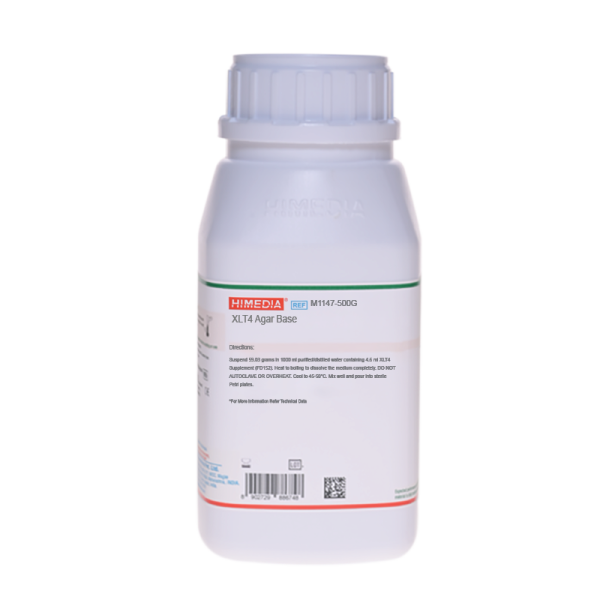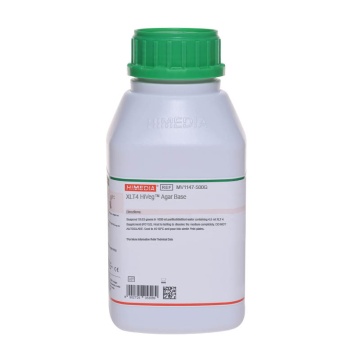 Your enquiry has been submitted
Your enquiry has been submitted
XLT4 Agar Base
Intended Use:
Recommended for selective isolation of Salmonella species other than Salmonella Typhi.
Composition**
| Ingredients | g/L |
|---|---|
| Proteose peptone | 1.600 |
| Yeast extract | 3.000 |
| L-Lysine | 5.000 |
| Xylose | 3.750 |
| Lactose | 7.500 |
| Saccharose (Sucrose) | 7.500 |
| Ferric ammonium citrate | 0.800 |
| Sodium thiosulphate | 6.800 |
| Sodium chloride | 5.000 |
| Phenol red | 0.080 |
| Agar | 18.000 |
Final pH (at 25°C): 7.4±0.2
**Formula adjusted, standardized to suit performance parameters
Directions
Suspend 59.03 grams in 1000 ml purified/distilled water containing 4.6 ml XLT4 Supplement (FD152). Heat to boiling to dissolve the medium completely. DO NOT AUTOCLAVE OR OVERHEAT. Cool to 45-50°C. Mix well and pour into sterile Petri plates.
Principle And Interpretation
Salmonella is a genus of gram-negative enterobacteria commonly implicated in foodborne illness and is the causative agent of typhoid and paratyphoid fever. Although most Salmonella cannot be distinguished by biochemical characteristics, one serotype, namely S. Typhi produce only a trace amount of hydrogen sulphide and is less active biochemically than the more common serotypes (1). XLT4 Agar Base is formulated as described by Miller and Tate (2) for isolating Salmonella from faecally contaminated farm samples, which contains other bacteria as well. XLT4 Agar Base enhances the recovery of Salmonella species other than Salmonella Typhi (3-7).
Proteose peptone is a source of carbon, nitrogen and other essential amino acids and growth factors. Yeast extract supplies nitrogenous requirements and vitamins required for growth. The sugars namely lactose, saccharose and xylose are the fermentable carbohydrates. Salmonella rapidly utilize xylose, producing acidity. Subsequently they decarboxylate lysine and revert to alkalinity. To add to the differentiating ability of the formulation, an H2S indicator system, consisting of sodium thiosulphate and ferric ammonium citrate is included for the visualization of the hydrogen sulphide produced, resulting in the formation of colonies with black centers. The non-pathogenic H2S producers do not decarboxylate lysine; therefore, the acid reaction generated by them prevents the blackening of the colonies (8).
XLT4 Agar is both selective and differential. Tergitol 4 (FD152) inhibits growth of non-Salmonella organisms. Presumptive Salmonella colonies should be confirmed by performing biochemical tests.
Type of specimen
Clinical samples - Faeces, Urine
Specimen Collection and Handling:
For clinical samples follow appropriate techniques for handling specimens as per established guidelines (9,10).
After use, contaminated materials must be sterilized by autoclaving before discarding.
Warning and Precautions :
In Vitro diagnostic use. For professional use only. Read the label before opening the container. Wear protective gloves/protective clothing/eye protection/ face protection. Follow good microbiological lab practices while handling specimens and culture. Standard precautions as per established guidelines should be followed while handling clinical specimens. Safety guidelines may be referred in individual safety data sheets.
Limitations :
- Further biochemical tests must be performed for confirmation.
Performance and Evaluation
Performance of the medium is expected when used as per the direction on the label within the expiry period when stored at recommended temperature.
Quality Control
Appearance Light yellow to pink homogeneous free flowing powder
Gelling Firm, comparable with 1.8% Agar gel.
Colour and Clarity of prepared medium Red coloured clear to slightly opalescent gel forms in Petri plates.
Reaction Reaction of 5.9% w/v aqueous solution at 25°C. pH : 7.4±0.2
pH 7.20-7.60
Cultural Response
Cultural characteristics observed after an incubation at 35-37°C for 18-24 hours with added XLT4 Supplement(FD152).
| Organism | Inoculum (CFU) | Growth | Recovery | Colour of colony |
|---|---|---|---|---|
| Enterococcus faecalis ATCC 29212 (00087*) | >=104 | inhibited | 0% | |
| Escherichia coli ATCC 25922 (00013*) | 50-100 | Fair-good | 30-40% | Yellow |
| Salmonella Enteritidis ATCC 13076 (00030*) | 50-100 | good-luxuriant | >=50% | red with black centers |
| Salmonella Typhimurium ATCC 14028 (00031*) | 50-100 | good-luxuriant | >=50% | red with black centers |
| Staphylococcus aureus subsp. aureus ATCC 25923 (00034*) | >=104 | inhibited | 0% | |
| Proteus mirabilis ATCC 25933 | 50-100 | none-poor | <=10% |
Key: *Corresponding WDCM numbers.
Storage and Shelf Life
Store between 10-30°C in a tightly closed container and the prepared medium at 2-8°C. Use before expiry date on the label. On opening, product should be properly stored dry, after tightly capping the bottle in order to prevent lump formation due to the hygroscopic nature of the product. Improper storage of the product may lead to lump formation. Store in dry ventilated area protected from extremes of temperature and sources of ignition Seal the container tightly after use. Product performance is best if used within stated expiry period.
Disposal
User must ensure safe disposal by autoclaving and/or incineration of used or unusable preparations of this product. Follow established laboratory procedures in disposing of infectious materials and material that comes into contact with clinical sample must be decontaminated and disposed of in accordance with current laboratory techniques (9,10).
Reference
- Koneman E. W., Allen S. D., Janda W. M., Schreckenberger P. C., Winn W. C. Jr., 1992, Colour Atlas and Textbook of Diagnostic Microbiology, 4th Ed., J. B. Lippinccott Company Chadwick P., Delisle G. H and Byer M., 1974, Can. J. Microbiol., 20.1653-1664.
- Miller R. G and Tate C. R., 1990, The Maryland Poultryman April 2-7
- Dusch H. and Altwegg M., 1994, Abstr. Annu. Meet. Am. Soc. Microbiol. C5:557
- Dusch H. and Altwegg M., 1995, J. Clin. Microbiol. 33: 802
- Miller R. G., Tate C. R., and Mallinson E. T. and Schemer J. A., 1991, Poultry science 70:2429
- Miller R. G., Tate C. R., and Mallinson E. T. and Schemer J. A., 1991, Poultry science 71:398
- Tate C. R., Miller R. G. and Mallinson E. T., 1992, J. Food. Prot. 55:964
- Taylor W. J., 1965, Am. J. Clin. Pathol., 44:471-475.
- Isenberg, H.D. Clinical Microbiology Procedures Handbook 2nd Edition.
- Jorgensen, J.H., Pfaller, M.A., Carroll, K.C., Funke, G., Landry, M.L., Richter, S.S and Warnock., D.W. (2015) Manual of Clinical Microbiology, 11th Edition. Vol. 1.
| Product Name | XLT4 Agar Base |
|---|---|
| SKU | M1147 |
| Product Type | Regular |
| Physical Form | Powder |
| Origin | Animal |
| Packaging type | HDPE |
| References | 1. Koneman E. W., Allen S. D., Janda W. M., Schreckenberger P. C., Winn W. C. Jr., 1992, Colour Atlas and Textbook ofDiagnostic Microbiology, 4th Ed., J. B. Lippinccott Company Chadwick P., Delisle G. H and Byer M., 1974, Can. J. Microbiol.,20.1653-1664. |
| Customized Product Available | No |







